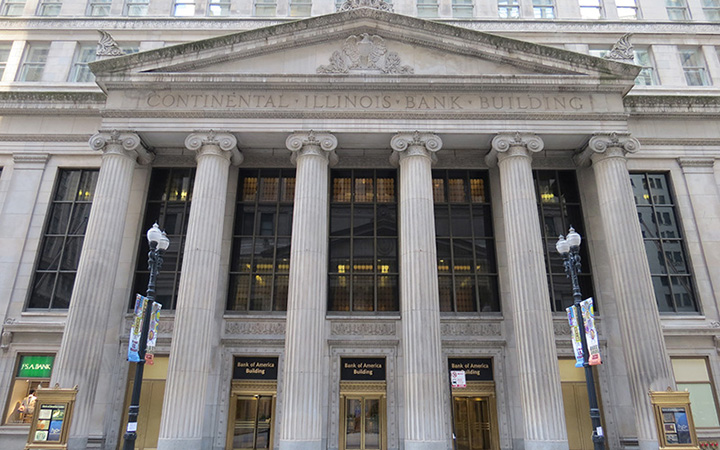Continental Illinois: A Bank That Was Too Big to Fail
May 1984

Continental Illinois was one of the largest banks in the United States before nearly failing in 1984.1 Federal regulators sought to avoid the bank’s failure, which they determined would have resulted in widespread economic harm, by providing the bank with substantial public financial support. The episode ignited a national debate that continues to this day over whether large financial institutions enjoy undue privileges because regulators consider them too big to fail.
Causes of Continental’s Crisis
Continental’s strategy of rapid growth during the late 1970s was at the core of its crisis. The bank aggressively competed for oil and gas loans amid the United States' drive for energy independence and funded that expansion with large-scale borrowing from money markets. Congressman Fernand St. Germain described it as "a dangerous situation in a bank now headed pell mell at top speed in the big time arenas of banking."2
By 1981, Continental had acquired a large amount of oil and gas loans from Penn Square Bank, an Oklahoma-based bank with a freewheeling culture in which the chief executive enjoyed “quaffing beer from his cowboy boot while entertaining out of town customers” like Continental.3 As Continental’s loan purchases from Penn Square accumulated, an employee in Continental’s oil and gas division warned in an internal memo that “potential credit problems could be going unnoticed” in those loans, and recommended that “corrective action should be instigated quickly."4 Her warnings, largely ignored, proved prescient when Penn Square failed in 1982, and details of Penn Square’s reckless loan underwriting became publicly known. One Penn square client said, "I could hardly believe it – they loaned me $2.5 million hardly asking any questions and then sold the loan to Continental."3 Neither Continental’s own internal control system nor federal regulators’ supervisory efforts fully appreciated the extent of these problems.
To fund its purchases of loans made by Penn Square, Continental tapped relatively risky funding sources. The bank had little ability to scale up funding from stable retail deposits because it was based in Chicago and Illinois state law at the time forbid banks from operating branches. (Continental owned just one building, pictured above.) Continental relied on money market sources, such as the eurodollar market, for much of its funding. These sources are generally more expensive and less stable than retail deposits. After Penn Square failed, Continental's creditors became concerned about the bank’s financial condition, which made it even more reliant on expensive and less stable funding sources. At the time of its rescue, insured deposits comprised only about 15 percent of Continental’s total liabilities.5
Crisis and bailout
A large-scale run by depositors on Continental began around May 7, 1984, amid rumors that the bank was in danger of failing. Over the next ten days, the bank lost about 30 percent of its funding. The run was generally electronic and spearheaded by depositors with large uninsured deposits and other bank creditors. The run was fast, and efforts to stem it required regulators to consider the incentives of other large banks, money market participants, and other sophisticated corporations that provided the bank with funding. To replace lost funds, Continental turned to the Federal Reserve Bank of Chicago for a discount window loan. It also received support from a group of sixteen large banks that publicly announced their support for Continental on May 15 in an effort to calm markets. The run on Continental finally stopped on May 17 when the FDIC, Federal Reserve, and Office of the Comptroller of the Currency—after vigorous internal debate about a range of possible options—announced a temporary assistance program.
This public assistance package was extraordinary in a few ways. The most important element was the FDIC’s announcement that it would guarantee of all of the bank’s creditors. The FDIC also lent Continental $2 billion. In addition, the Federal Reserve announced that "as a part of the overall program, and in accordance with customary arrangements, the Federal Reserve is prepared to meet any extraordinary liquidity requirements" of Continental.6
Continental’s funding situation stabilized for a couple of months, but the bank run resumed. When firms began pulling money from the bank again later in the summer, the FDIC announced an additional support plan that involved the FDIC taking 80 percent ownership in Continental’s holding company and assuming responsibility for Continental’s loan from the Federal Reserve.7 With this support, Continental was able to avoid failure, though its shareholders lost their investments in the bank and its management was fired. The FDIC ultimately estimated its loss was about $1.1 billion, equal to about 3 percent of Continental’s assets at the time of its intervention.8 Continental was eventually purchased by Bank of America in 1994.
Regulators intervened in this extraordinary way because of concerns that Continental’s failure would have had major repercussions in the financial system. At least 180 other banks had substantial exposures to Continental, which acted as a correspondent bank that provided services to hundreds of other banks, particularly in the Midwest.9 A Continental failure would have exposed those banks to potential losses. Another fear was that at least two large banks (unnamed in the public record) might come under pressure if Continental had failed, likely because of disruptions in wholesale funding markets or general confidence in the safety of the banking system. Researchers have debated whether market participants saw contagion as likely, finding mixed but generally weak evidence from stock market prices of other banks.10 Other research has identified a handful of large financial institutions that had very sizable exposures to Continental.5
Continental’s bailout was met with widespread outrage. In congressional hearings over Continental’s bailout, Comptroller of the Currency C. T. Conover admitted that "we don’t have a way right now" to manage the failure of the nation’s largest banks. Many commentators viewed Conover’s statement as applying to the largest eleven banks that he had discussed just prior. Conover’s admission prompted Congressman Stewart McKinney to interject, "let us not bandy words. We have a new kind of bank. It is called too big to fail. TBTF, and it is a wonderful bank."11 The phrase "too big to fail" became commonly used in the public lexicon as a result of Continental’s crisis. Critics charged that if regulators were to prevent large financial institutions from failing as a matter of policy, such institutions would have an incentive to take on more risk, potentially earning undue profits and relying on bailouts if losses arose. Critics also charged that banks deemed too big to fail could borrow at cheaper rates than other banks, thus creating an unlevel playing field.
Continental’s Place in History
Continental was the highest-profile bank to experience a crisis between 1933 and 2008. Its crisis illustrates the limitations of the regulatory regime created after the Great Depression, and foreshadows some of the financial stability issues that have since re-emerged.
One pillar of the post-Depression regulatory regime is deposit insurance. It is striking that Continental joined the federal deposit insurance system only under protest, in 1937. At the time, the bank’s executives argued to the FDIC that the compulsory nature of the deposit insurance system was unconstitutional.12 The fact that only 15 percent of Continental’s deposits were insured in 1984 illustrates that the deposit insurance system does not prevent banks from taking on substantial funding risks by acquiring sizable amounts of uninsured deposits or other liabilities.
Depositors with large accounts are uninsured because they are presumed to be sophisticated and therefore have the ability to evaluate and discipline banks by withdrawing funds from banks they perceive as taking on too many risks. But financial stability concerns can arise if uninsured depositors are exposed to losses, as illustrated by Continental. Such concerns rose again, for example, in 2008, when the FDIC would again take the extraordinary step of extending deposit insurance coverage, in that case to transaction accounts such as those used by large corporations for business-critical payment operations.13 These concerns rose again in 2023, when withdrawals by uninsured depositors contributed to several bank closures and the extension of insurance coverage to certain uninsured depositors by the FDIC.
These episodes of banking turmoil, from 1984 to 2023, featured concerns about too big to fail financial institutions. These concerns had been building before 1984, for example including in the cases of Franklin National Bank in 1974 and First Pennsylvania Bank in 1980.14 In fact, Continental itself had been deemed too big to fail even in the 1930s: In 1933, Continental received a public capital injection from the Reconstruction Finance Corporation because "had it collapsed, the effect would have been frighteningly felt in fields and towns and cities over a large area of the country."15 More than 50 years later, Irvine Sprague, who was on the FDIC’s Board during Continental’s crisis, would look back on Continental’s place in the 1933 financial system and observe that "This is still true today, except that Continental’s reach extends overseas now, and the repercussions of the bank’s failure in 1984 would have been felt worldwide."16
The too big to fail problem only deepened over time as the very largest banks have grown in size, and even as policymakers took steps after Continental’s crisis to address the problem. The Federal Deposit Insurance Corporation Improvement Act (FDICIA), passed in 1991, layered on a system of accountability, requiring the FDIC to secure approval from its board, the Federal Reserve Board, and the Treasury secretary in consultation with the President of the US before protecting uninsured bank creditors from losses in the name of preserving financial stability. The Act also limits Federal Reserve loans to “critically undercapitalized” banks, which are at significant risk of failing. The Dodd-Frank Act brought more reforms, including (i) establishing a special process at the federal level for the orderly resolution of systemically important financial firms, (ii) subjecting such firms to heightened supervision and regulation, and (iii) requiring large banks to create living wills to aid in their resolution if necessary.
Finally, Continental illustrates the challenges faced across the banking system during the 1980s. These challenges would not rise to the significance of those experienced in the 1930s or 2000s, but they were the principal cause of the more than 1,600 banks that closed or received financial assistance from the FDIC between 1980 and 1994.17 Many factors contributed to these failures, including increased competition amidst the beginning of deregulation, a severe recession in the early 1980s that created a challenging economic environment for all banks, and severe problems in specific sectors, including oil and gas loans and Latin American debt.18 Indeed, the Latin American debt crisis that became acute starting in 1982 was an additional source of loan delinquencies at Continental. Continental stands out in this period because of its place among the largest US banks and the exceptional government bailout it received.
Endnotes
- 1 Continental did not fail, since it never closed. However, it likely would have failed if it had not received financial support from the federal government. In this essay, the term "Continental Illinois" is intended as a reference to the holding company, Continental Illinois Corporation. The main subsidiary of this holding company was Continental Illinois National Bank and Trust Company.
- 2 United States. Congress. House. Committee on Banking, Currency and Housing. Subcommittee on Financial Institutions Supervision, Regulation and Insurance. Inquiry into Continental Illinois Corp. and Continental Illinois National Bank. 98th Congress, 1st Session, September 18, 19 and October 4, 1984: 3.
- 3 "Penn Square’s Failed Concept." New York Times, August 16, 1982.
- 4 Inquiry into Continental Illinois Corp. and Continental Illinois National Bank: 100.
- 5 Carlson, Mark A., and Jonathan D. Rose (2016). "Can a Bank Run Be Stopped? Government Guarantees and the Run on Continental Illinois." Board of Governors of the Federal Reserve System Finance and Economics Discussion Series no. 2016-003, January 21, 2016.
- 6 "Text of F.D.I.C. Aid Announcement." New York Times, May 18, 1984.
- 7 Along with assuming Continentals’ discount window loan, the FDIC also received an equal amount of loans and an option to buy stock in Continental if the loans lost value, an option which the FDIC did eventually exercise.
- 8 Federal Deposit Insurance Corporation. History of the Eighties: Lessons for the Future, Volume 1, 1997: 245. This calculation likely underestimates the true economic cost, which would take into account the risks the government incurred by making this investment. In other words, how much money would the government, or a typical investor, have expected to make on another investment with a similar level of risk?
- 9 FDIC. History of the Eighties: 250.
- 10 Larry D. Wall and David R. Peterson. "The Effect of Continental Illinois' Failure on the Financial Performance of Other Banks." Journal of Monetary Economics 26, no. 1 (1990): 77-99; Itzhak Swary. "Stock market reaction to regulatory action in the Continental Illinois crisis." Journal of Business 59, no. 6 (July 1986): 451-473; Subbarao V. Jayanti and Ann Marie Whyte. "Global Contagion Effects of the Continental Illinois Failure." Journal of International Financial Markets, Institutions and Money 6 (1996): 87-98; Frederick Furlong. "Market Responses to Continental Illinois." Federal Reserve Bank of San Francisco Weekly Letter, August 31, 1984.
- 11 Inquiry into Continental Illinois Corp. and Continental Illinois National Bank: 300.
- 12 Irvine H. Sprague. Bailout: An Insider’s Account of Bank Failures and Rescues. Basic Books, 1986: 232.
- 13 Federal Deposit Insurance Corporation. "Temporary Liquidity Guarantee Program." February 19, 2019.
- 14 Sprague, Bailout, chapters 3-5; Robert L. Hetzel. "Too Big to Fail: Origins, Consequences, and Outlook." Economic Review (Federal Reserve Bank of Richmond) 77, no. 6 (1991): 3-15; George C. Narusso and Edward S. Prescott. "The 1970s Origins of Too Big to Fail." Federal Reserve Bank of Cleveland Economic Commentary 2017-17.
- 15 Jesse Holman Jones, and Edward Angly. Fifty Billion Dollars: My Thirteen Years with the RFC, 1932-1945. Macmillan, 1951: 46.
- 16 Sprague, Bailout: 232.
- 17 FDIC, History of the Eighties: 19.
- 18 Lynn Seballos and James B. Thomson. "Underlying Causes of Commercial Bank Failures in the 1980s." Federal Reserve Bank of Cleveland Economic Commentary September 1, 1990; Rebel A. Cole and Jeffery W. Gunther. "Predicting Bank Failures: A Comparison of On-and Off-Site Monitoring Systems." Journal of Financial Services Research 13, no. 2 (1998): 103-117.
Written as of May 15, 2023. Jonathan Rose contributed to this article. Please cite this essay as: Federal Reserve History. "Continental Illinois: A Bank That Was Too Big to Fail." May 15, 2023. See disclaimer and update policy.



